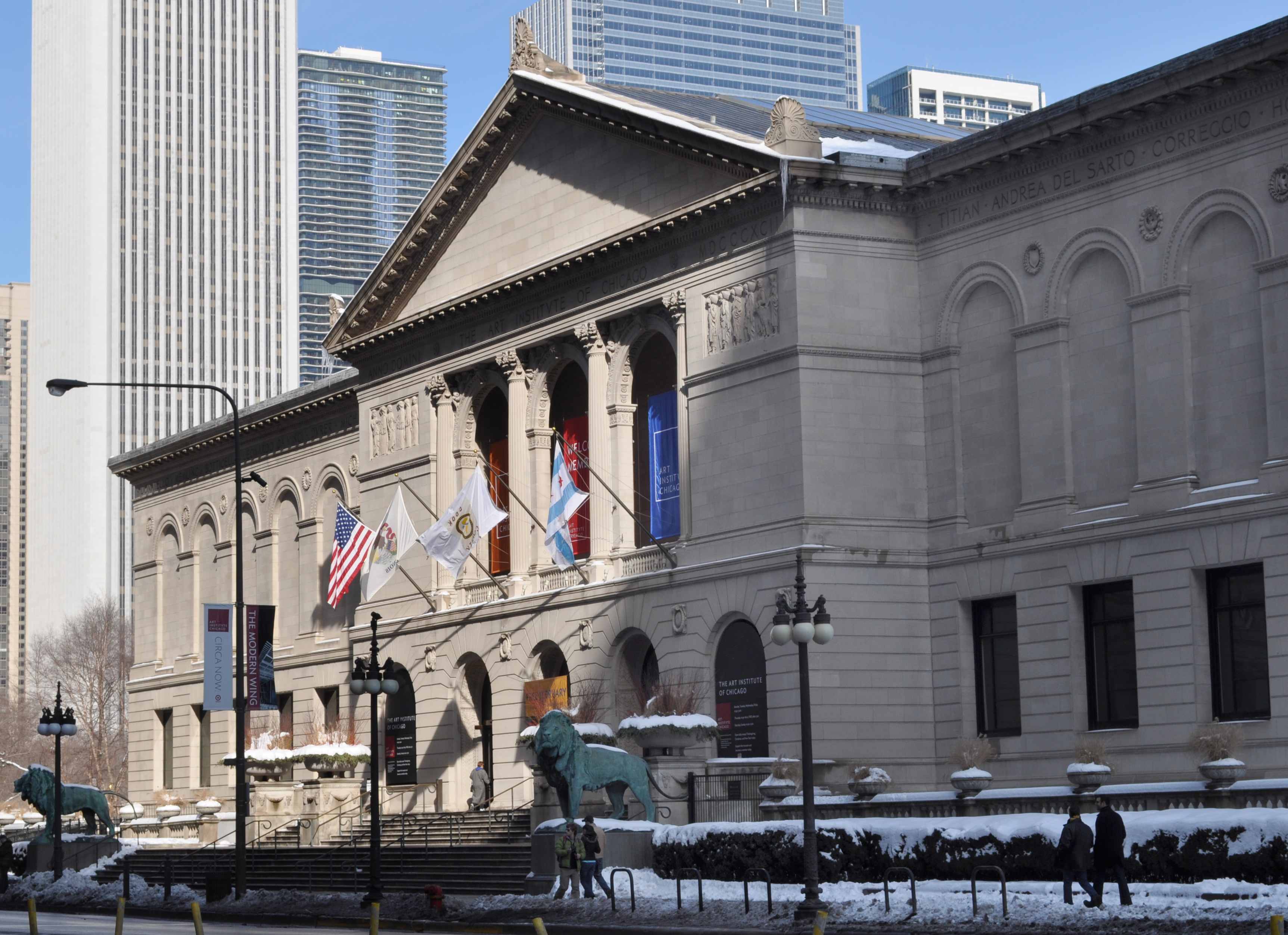Art Institute of Chicago
by Donald G. Evans

Photograph by Floyd Sullivan
The Art Institute of Chicago found its permanent home at this location on Michigan Avenue and Adams Street in 1893, a product of the vast effort to rebuild the city in the wake of the Great Chicago Fire. The construction, on what is now recognized as the traditional homelands of the Council of Three Fires—the Ojibwe, Odawa, and Potawatomi peoples—was a joint effort with the city of Chicago for the World’s Columbian Exposition. The Art Institute was founded as both a museum and a school for the fine arts, with eight major expansions added since its original construction, from the research library in 1901 to the Modern Wing in 2009.
The School of the Art Institute of Chicago’s Writing Program consistently boasts a star-studded faculty, including at the present James McManus (Positively Fifth Street), Sara Levine (Treasure Island!!!), and Rosellen Brown (The Lake on Fire); it has also produced many successful students, such as David Sedaris (Barrel Fever), Audrey Niffenegger (The Time Traveler’s Wife), and Chris Ware (Jimmy Corrigan, the Smartest Kid on Earth). Jesse Ball and other luminaries either taught or studied at the Art Institute over the years.
Not surprisingly, the Art Institute, and its precursor, the Chicago Academy of Fine Arts, trained a good many cartoonists who would later go on to distinguished careers. Frank King, creator of Gasoline Alley, attended the Academy of Fine Arts in 1905-06. Billy DeBeck (Barney Google) enrolled at the college after graduating from Hyde Park High School in 1908. Frank Willard, creator of Moon Mullins, attended for about three months in 1913. “I was suspended part of that time because I couldn't get credit for 35 cents' worth of art supplies,” he said. Ferd Johnson, who succeeded Willard on the Moon Mullins strip, took classes for three months in 1923. "It was quite a group, and they were wonderful with me," said Johnson. "In fact, I had four or five top men in the business as my teachers. Needless to say, I dropped out of art school after two months." Shel Silverstein took classes in 1950 for about a year. Many contemporary artists like Laura Park and Turtel Onli also were students.
But this venerable institution’s reputation leans heavily toward high culture, and that seeps its way into Chicago literature, and in at least one case vice versa.
Jules Breton’s 1884 painting The Song of the Lark inspired the title of Willa Cather’s novel, in which Thea Kronborg, a minister's daughter in Moonstone, Colorado, journeys to Chicago to pursue her artistic ambitions.
The narrator writes, “One bleak day in February, when the wind was blowing clouds of dirt like a Moonstone sandstorm, dirt that filled your eyes and ears and mouth, Thea fought her way across the unprotected space in front of the Art Institute and into the doors of the building. She did not come out again until the closing hour. In the street-car, on the long cold ride home, while she sat staring at the waistcoat buttons of a fat strap-hanger, she had a serious reckoning with herself. She seldom thought about her way of life, about what she ought or ought not to do; usually there was but one obvious and important thing to be done. But that afternoon she remonstrated with herself severely. She told herself that she was missing a great deal; that she ought to be more willing to take advice and to go see things. She was very sorry that she had let months pass without going to the Art Institute. After this she would go once a week.” In Cather’s novel, which is the middle book of her Great Plains Trilogy, Thea comes to use the Art Institute as a place of retreat, and her discovery of the museum serves as a turning point in her self-education. Thea spends the majority of her time exploring the statues, but finds greater joy in the paintings. “It was with a lightening of the heart, a feeling of throwing off the old miseries and old sorrows of the world, that she ran up the wide staircase to the pictures,” the narrator writes. And, of course, there is one painting in particular that resonates. “But in that same room there was a picture—oh, that was the thing she ran upstairs so fast to see! That was her picture. She imagined that nobody cared for it but herself, and that it waited for her. That was a picture indeed. She liked even the name of it, ‘The Song of the Lark.’ The flat country, the early morning light, the wet fields, the look in the girl’s heavy face—well, they were all hers, anyhow, whatever was there. She told herself that that picture was ‘right.’ Just what she meant by this, it would take a clever person to explain. But to her the word covered the almost boundless satisfaction she felt when she looked at the picture.”
Several other Chicago authors would include the Art Institute in their fiction. Lloyd C. Douglas’s Green Light, a 1935 novel featuring an Episcopal priest living with the after-effects of polio, includes a number of detailed scenes set in the Art Institute; the art works have deep resonance for several of the characters. In Theodore Dreiser’s semi-autobiographical novel The Genius (1915), Eugene Witla leaves the small Illinois town of his youth to study at the Art Institute and his experiences in Chicago evoke the life of the 1890’s Bohemian.
More recently, the Thorne Miniature Rooms, one of the Art Institute’s most beloved exhibits, inspired author Marianne Malone to write a series of young adult time travel books. Sixth graders Ruthie and Jack discover a magical key that allows them to shrink small enough to fit into the Thorne Rooms, where they discover that some of the rooms act as portals to other times and places. The Thorne Rooms consist of 68 miniature detailed representations of rooms that might have existed in Europe and America over some six centuries. The four-book series is made up of: The Sixty-Eight Rooms (2010), Stealing Magic (2011), The Pirate’s Coin (2013), and The Secret of the Key (2014).
Blue Balliett also uses the Art Institute in her young adult novel Chasing Vermeer, in which a Johannes Vermeer painting, A Lady Writing, is stolen in transport between the National Gallery and the Art Institute. Calder and Petra try to recover the painting, and their sleuthing inevitably leads them to the museum itself. “After they had eaten packed lunches next to the bronze lions on the steps of the museum, they fanned out in the European wing. Petra took off on her own. She passed the Degas dancers, the big painting made completely of dots, the Monet haystacks and bridges, and headed for the older works. When she was in third grade, she’d had a baby-sitter who took her to the Art Institute once a month. The baby-sitter would sit in front of a painting, sigh a great deal, and sometimes write things down. She’d tell Petra to stay in one area, but not to bother her. Petra would walk around looking. Soon she began to wonder which paintings would be fun to go into, or which ones she might like to play with. Her baby-sitter gave her a pad and pencil, and Petra made lists. She once counted all the paintings with red clothing in them. Another time she secretly counted all the bare bottoms. She also counted all the hats and found 123.”
A story in Stuart Dybek's brilliant collection The Coast of Chicago is named after a painting hung in the Art Institute. In “Nighthawks,” the narrator stands before Edward Hopper's famous 1942 painting of a corner diner, closes his eyes, and thinks to himself: ''It was night in Hopper's painting; the diner illuminated the dark city corner with a stark light it didn't seem capable of throwing on its own. Three customers sat at the counter as if waiting, not for something to begin, but rather to end, and I knew how effortless it would be to open my eyes and find myself waiting there, too.''
But it was another Chicago writer, Ernest Hemingway, who inspired Hopper to create the painting in the first place. Hemingway, born and raised in Oak Park, almost never used Chicago as a setting, with “The Killers” (1927) being a rare exception. According to Hopper’s biographer, Gail Levin, he was inspired to paint “Nighthawks” after reading Hemingway's story, in which two hit men linger at a 24-hour diner while waiting to murder a has-been boxer for some undisclosed violation. The broken clock in Hemingway’s story creates a sense of confusion over time that Hopper emulates in his somber-toned painting.
In fact, the vast Art Institute collection shows a fairly strong connection between the literary and visual arts. The Art Institute’s holdings include four Art Shay photographs of Nelson Algren, all taken around 1949 or 1950 and included in his book, Nelson Algren’s Chicago (1988). Art Shay’s photos are: “Nelson Algren Pauses after Another White Sox Loss” (1950), “Nelson Algren, by his Favorite Division Street Bar” (1949), “Nelson Algren Amuses a New Friend” (1949), and “Nelson Algren Playing Cards” (1949). In addition, the Art Institute collection includes a variety of other paintings with Chicago writerly connections, such as Ivan Albright’s “Captain Joseph Medill Patterson” (1962/64) and Chester Gould’s “Sparkle Plenty Welcomes Mr. Kubicek and Mr. Gould” (1950s). There is also a floor plan for the Playboy Club International and various plans submitted to the Chicago Tribune Tower Competition in 1922.
There are many other literary connections having nothing to do with Chicago, such as Ivan Albright’s “Picture of Dorian Gray” (1945), which takes as its subject Oscar Wilde’s fictional character. Onchi Koshiro’s “Portrait of the Poet Hagiwara Sakutaro” (1943) serves as a tribute to the author of “Ice Island” who had died the previous year. Ilse Bing’s “Jerome Mellquist at Typewriter” (1931) features the art historian and critic, while Etienne Carjat’s “Charles Baudelaire” (c. 1863) portrays the French poet, critic, and writer, who lived from 1821-1867.
Many of the Art Institute’s collected works have some resonance with literature, such as:
• Rembrandt van Rijn’s “Woman Reading” (1634)
• Yashima Gakutei’s “Woman About to Write a Poem” (c. 1824)
• Jonas Welch Holman’s “Man with a Pen” (c. 1827)
• Katsushika Hokuga’s colored woodblock print entitled, “Woman Reading Poems in a Study Room” (c. 1833)
• James McNeill Whistler’s “Reading by Lamplight” (1859) and “The Little Nude Model, Reading” (1889/90)
• Édouard Manet’s “Woman Reading” (1879/1880)
• Mary Cassatt’s “Reading the Newspaper” (1883)
• Vincent van Gogh’s “The Poet’s Garden” (1888)
• Albert André’s “Woman Reading Before Window” (1903)
• Edouard Vuillard’s “The Dressing-Room, Madame Hessel Reading at Amfréville” (1906)
• Henri Matisse’s “A Girl Reading” (1923)
• Pablo Picasso’s “Reading” (1925–26)
• Stanley Anderson’s “The Reading Room” (1930)
• Hans Hofmann’s “The Poet” (1940)
• Julia Thecla’s “Books” (1942)
• Larry Sultan’s “Reading in Bed” (1985)
• Charles Vernier’s “The Literary Life,” a French cartoon.
Over the past century, the Art Institute has hosted many, many literary events that have featured some of the country’s best writers. Former Poet Laureate Phillip Levine read in Fullerton Hall in 2009. Nobel Prize-winning poet Seamus Heaney gave the National Poetry Day reading at the Art Institute in 2012. As part of the Our Miss Brooks 100 series celebrating Gwendolyn Brooks’s centennial, 750 people filled Rubloff Auditorium to hear a joint reading with the five living African-American Pulitzer Prize-winning poets: Rita Dove, Yusef Komunyakaa, Natasha Trethewey, Tracy K. Smith and Gregory Pardlo. The poets read their own poems as well those of Brooks, and answered questions from WBEZ-FM's Natalie Moore.
The Chicago Humanities Festival has partnered with the Art Institute on many programs, bringing other Pulitzer Prize winners like Colson Whitehead and David McCullough to these halls. Chicago writers, too, have been well represented in the museum’s programming schedule, with Dybek and Brown among the list of readers. Poets like Ruben Quesada and Coya Paz have read poems inspired by the Art Institute’s collection of African and American Indian art. Angela Jackson was one of many Chicago writers to appear as part of The Reading and Conversation Series.
The Art Institute’s Reading Between the Lions Book Club was another popular program that connected visitors to literature.








